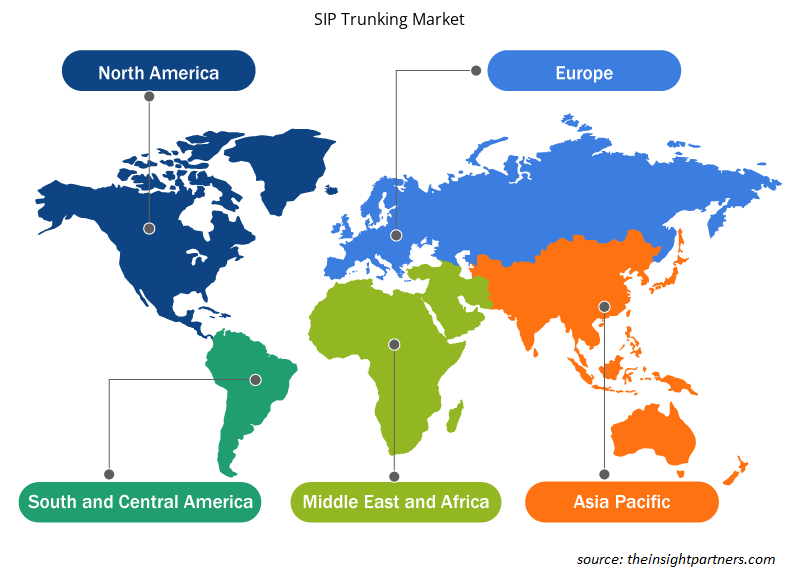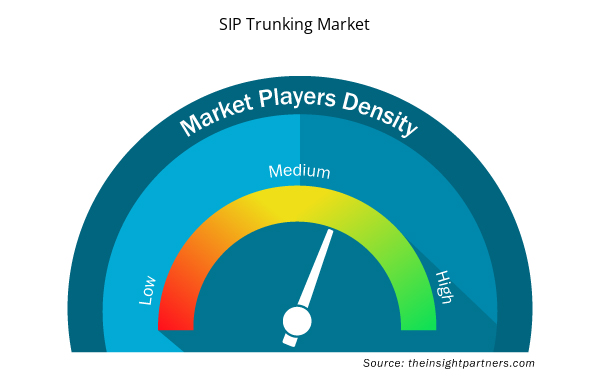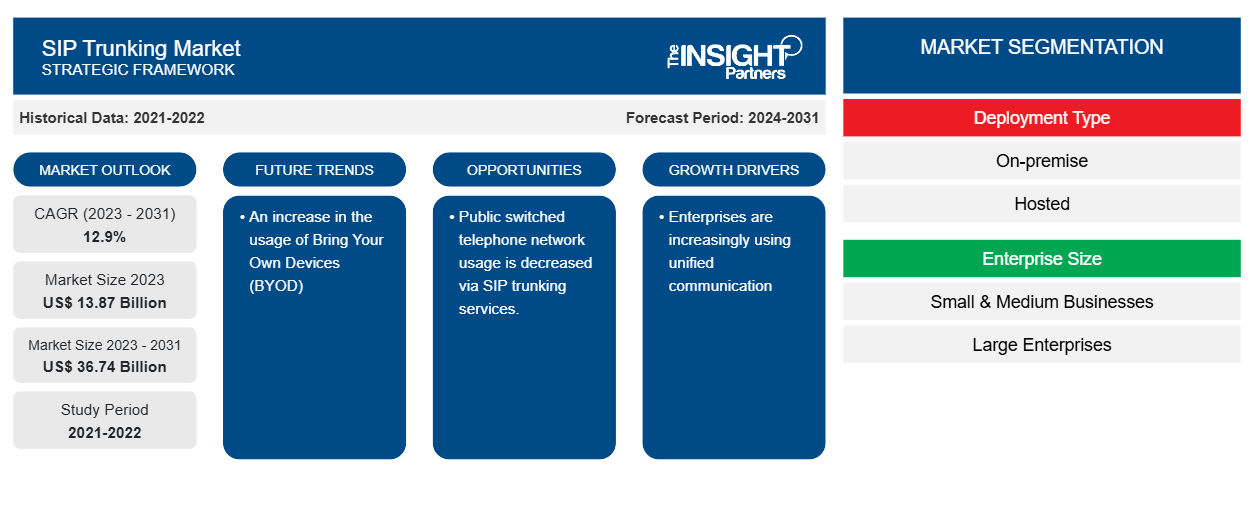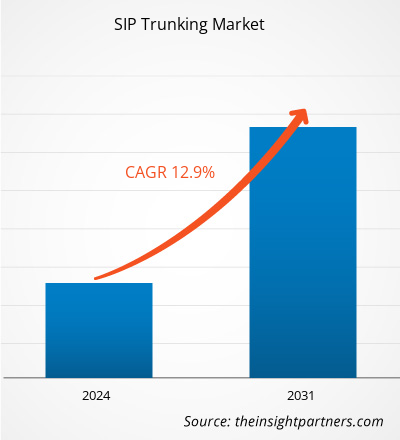Si prevede che la dimensione del mercato del trunking SIP raggiungerà i 36,74 miliardi di dollari entro il 2031, rispetto ai 13,87 miliardi di dollari del 2023. Si prevede che il mercato registrerà un CAGR del 12,9% nel 2023-2031. È probabile che un aumento dell'utilizzo di Bring Your Own Devices (BYOD) a livello globale rimanga una tendenza chiave del mercato del trunking SIP.
Analisi di mercato del trunking SIP
La necessità di trunking SIP è guidata dal crescente utilizzo di soluzioni di comunicazione unificata (UC) in contesti aziendali, da una notevole diminuzione delle spese telefoniche e da un rapido ritorno sull'investimento (ROI) reso possibile dai servizi di trunking. La domanda di servizi di trunking SIP è aumentata perché hanno eliminato la necessità per le aziende di acquistare gateway PSTN (Public Switched Telephone Network) aggiuntivi. La domanda di trunking SIP è guidata dalla necessità di aumentare l'affidabilità del servizio tramite l'aggiunta di servizi VoIP e la fornitura di diverse capacità di streaming digitale. Tuttavia, le crescenti preoccupazioni per la sicurezza degli utenti finali stanno ostacolando l'espansione del business del trunking SIP. D'altro canto, si prevede che il crescente utilizzo del trunking SIP in settori verticali, tra cui sanità, ospitalità e ristoranti, presenterà una serie di opportunità per la crescita del mercato del trunking SIP.
Panoramica del mercato del trunking SIP
Il servizio di un fornitore di servizi di comunicazione, noto come "SIP trunking", impiega il protocollo di avvio della sessione (SIP) per fornire accesso voice-over IP (VoIP) tra una rete telefonica pubblica commutata (PSTN) e un sistema telefonico locale. Il servizio di trunking SIP viene utilizzato per l'avvio, l'amministrazione, la gestione e lo smantellamento delle chiamate. I servizi di trunking SIP ospitati e locali sono le due categorie principali. Con un centralino privato (PBX) ospitato, gli utenti possono utilizzare le funzioni PBX come segreteria telefonica, trasferimento di chiamata, operatore automatico e distribuzione automatica delle chiamate senza dover gestire o possedere tutto l'hardware necessario in loco.
Personalizza questo report in base alle tue esigenze
Riceverai la personalizzazione gratuita di qualsiasi report, comprese parti di questo report, o analisi a livello nazionale, pacchetto dati Excel, oltre a usufruire di grandi offerte e sconti per start-up e università
- Scopri le principali tendenze di mercato in questo rapporto.Questo campione GRATUITO includerà analisi di dati che spaziano dalle tendenze di mercato alle stime e alle previsioni.
Driver e opportunità del mercato del trunking SIP
Le aziende utilizzano sempre più spesso la comunicazione unificata.
L'Internet Telephony Service Provider (ITSP) offre un servizio chiamato SIP trunk che facilita la comunicazione tra l'ITSP e il Private Branch Exchange (PBX) aziendale. Il SIP trunk consente alle aziende di offrire connettività Public Switched Telephone Network (PSTN) utilizzando una rete IP, come Internet, in contrasto con i tradizionali servizi di telefonia, che prevedono che un service provider fornisca fasci di cavi fisici a un'azienda. Ciò sta motivando le aziende a implementare soluzioni di Unified Communication (UC) per risparmiare sulle spese telefoniche e aumentare il ritorno sull'investimento, con l'aiuto del SIP trunking. Il mercato globale del SIP trunking si sta espandendo grazie a questo fattore.
L'utilizzo della rete telefonica pubblica commutata viene ridotto tramite i servizi di trunking SIP.
Poiché i dispositivi edge del servizio di trunking SIP sono spesso meno costosi per linea rispetto allo stesso sistema gateway PSTN tradizionale, installarne uno nella rete di comunicazione di un'organizzazione fornisce un percorso meno costoso per aggiungere nuove linee. Il mercato dei servizi di trunking SIP ottimizza notevolmente l'uso della larghezza di banda, aumentando l'efficienza della rete tramite la distribuzione sia di voce che di dati sullo stesso collegamento. Il mercato dei servizi di trunking SIP è guidato dalla capacità di un'azienda di effettuare chiamate internazionali al costo di una chiamata locale utilizzando il servizio di trunking SIP. Pertanto, si prevede che l'uso della rete telefonica pubblica commutata diminuisca tramite trunking SIP e presenti nuove opportunità per gli operatori del mercato del trunking SIP durante il periodo di previsione.
Analisi della segmentazione del rapporto di mercato del trunking SIP
I segmenti chiave che hanno contribuito alla derivazione dell'analisi di mercato del trunking SIP sono il tipo di implementazione, le dimensioni dell'azienda e l'utente finale.
- In base al tipo di distribuzione, il mercato del trunking SIP è diviso in on-premise e cloud. Il segmento cloud ha detenuto una quota di mercato maggiore nel 2023.
- In base alle dimensioni dell'impresa, il mercato è segmentato in piccole e medie imprese e grandi imprese.
- In base agli utenti finali, il mercato del trunking SIP è segmentato in istruzione, IT e telecomunicazioni, commercio al dettaglio, media e intrattenimento, BFSI, sanità e pubblica amministrazione.
Analisi della quota di mercato del trunking SIP per area geografica
L'ambito geografico del rapporto di mercato del trunking SIP è suddiviso principalmente in cinque regioni: Nord America, Asia Pacifico, Europa, Medio Oriente e Africa e Sud America/Sud e Centro America. In termini di fatturato, il Nord America ha rappresentato la quota di mercato del trunking SIP più grande. Questi mercati inesplorati presentano enormi possibilità per i provider di servizi SIP. I servizi di trunking SIP vengono adottati da operatori all'ingrosso e aziende in queste località come un sostituto affidabile e conveniente per i sistemi telefonici tradizionali al fine di ottenere una connettività affidabile all'interno delle organizzazioni, indipendentemente dalla geografia.
Approfondimenti regionali sul mercato del trunking SIP
Le tendenze regionali e i fattori che influenzano il mercato del trunking SIP durante il periodo di previsione sono stati ampiamente spiegati dagli analisti di Insight Partners. Questa sezione discute anche i segmenti e la geografia del mercato del trunking SIP in Nord America, Europa, Asia Pacifico, Medio Oriente e Africa e America centrale e meridionale.

- Ottieni i dati specifici regionali per il mercato del trunking SIP
Ambito del rapporto sul mercato del trunking SIP
| Attributo del report | Dettagli |
|---|---|
| Dimensioni del mercato nel 2023 | 13,87 miliardi di dollari USA |
| Dimensioni del mercato entro il 2031 | 36,74 miliardi di dollari USA |
| CAGR globale (2023-2031) | 12,9% |
| Dati storici | 2021-2022 |
| Periodo di previsione | 2024-2031 |
| Segmenti coperti | Per tipo di distribuzione
|
| Regioni e Paesi coperti | America del Nord
|
| Leader di mercato e profili aziendali chiave |
|
Densità degli attori del mercato: comprendere il suo impatto sulle dinamiche aziendali
Il mercato del SIP Trunking sta crescendo rapidamente, spinto dalla crescente domanda degli utenti finali dovuta a fattori quali l'evoluzione delle preferenze dei consumatori, i progressi tecnologici e una maggiore consapevolezza dei vantaggi del prodotto. Con l'aumento della domanda, le aziende stanno ampliando le loro offerte, innovando per soddisfare le esigenze dei consumatori e capitalizzando sulle tendenze emergenti, il che alimenta ulteriormente la crescita del mercato.
La densità degli operatori di mercato si riferisce alla distribuzione di aziende o società che operano in un particolare mercato o settore. Indica quanti concorrenti (operatori di mercato) sono presenti in un dato spazio di mercato in relazione alle sue dimensioni o al valore di mercato totale.
Le principali aziende che operano nel mercato del trunking SIP sono:
- Collegamento del secolo
- AT&T
- Larghezza di banda
- Mitel
- Rete2Telefono
- Comunicazioni GTT
Disclaimer : le aziende elencate sopra non sono classificate secondo un ordine particolare.

- Ottieni una panoramica dei principali attori del mercato dei trunk SIP
Notizie e sviluppi recenti sul mercato del trunking SIP
Il mercato del trunking SIP viene valutato raccogliendo dati qualitativi e quantitativi dopo la ricerca primaria e secondaria, che include importanti pubblicazioni aziendali, dati associativi e database. Di seguito è riportato un elenco degli sviluppi nel mercato dei disturbi e delle strategie del linguaggio e della parola:
- Nell'agosto 2021, 8x8, Inc. ha firmato un nuovo accordo di distribuzione con SYNNEX Corporation per dare accesso a 8x8 XCaaS alla community di partner di SYNNEX composta da tradizionali rivenditori a valore aggiunto (VAR), integratori di sistemi e fornitori di servizi gestiti (MSP).
(Fonte: 8x8, Inc, Comunicato stampa)
Copertura e risultati del rapporto sul mercato del trunking SIP
Il rapporto "Dimensioni e previsioni del mercato del trunking SIP (2021-2031)" fornisce un'analisi dettagliata del mercato che copre le seguenti aree:
- Dimensioni e previsioni del mercato a livello globale, regionale e nazionale per tutti i segmenti di mercato chiave coperti dall'ambito
- Dinamiche di mercato come fattori trainanti, vincoli e opportunità chiave
- Principali tendenze future
- Analisi dettagliata delle cinque forze PEST/Porter e SWOT
- Analisi di mercato globale e regionale che copre le principali tendenze di mercato, i principali attori, le normative e gli sviluppi recenti del mercato
- Analisi del panorama industriale e della concorrenza che copre la concentrazione del mercato, l'analisi della mappa di calore, i principali attori e gli sviluppi recenti
- Profili aziendali dettagliati
- Analisi storica (2 anni), anno base, previsione (7 anni) con CAGR
- Analisi PEST e SWOT
- Valore/volume delle dimensioni del mercato - Globale, regionale, nazionale
- Industria e panorama competitivo
- Set di dati Excel



Report Coverage
Revenue forecast, Company Analysis, Industry landscape, Growth factors, and Trends

Segment Covered
This text is related
to segments covered.

Regional Scope
North America, Europe, Asia Pacific, Middle East & Africa, South & Central America

Country Scope
This text is related
to country scope.
Domande frequenti
The global SIP trunking market was estimated to be US$ 13.87 billion in 2023 and is expected to grow at a CAGR of 12.9% during the forecast period 2023 - 2031.
Enterprises are increasingly using unified communication, and public switched telephone network usage is decreased via SIP trunking services are the major factors that propel the global SIP trunking market.
The increase in usage of Bring Your Own Devices (BYOD) globally is anticipated to play a significant role in the global SIP trunking market in the coming years.
The key players holding majority shares in the global SIP trunking market are CenturyLink, AT&T, Bandwidth, Mitel, and Net2Phone.
The global SIP trunking market is expected to reach US$ 36.74 billion by 2031.
Trends and growth analysis reports related to Technology, Media and Telecommunications : READ MORE..
The Insight Partners performs research in 4 major stages: Data Collection & Secondary Research, Primary Research, Data Analysis and Data Triangulation & Final Review.
- Data Collection and Secondary Research:
As a market research and consulting firm operating from a decade, we have published and advised several client across the globe. First step for any study will start with an assessment of currently available data and insights from existing reports. Further, historical and current market information is collected from Investor Presentations, Annual Reports, SEC Filings, etc., and other information related to company’s performance and market positioning are gathered from Paid Databases (Factiva, Hoovers, and Reuters) and various other publications available in public domain.
Several associations trade associates, technical forums, institutes, societies and organization are accessed to gain technical as well as market related insights through their publications such as research papers, blogs and press releases related to the studies are referred to get cues about the market. Further, white papers, journals, magazines, and other news articles published in last 3 years are scrutinized and analyzed to understand the current market trends.
- Primary Research:
The primarily interview analysis comprise of data obtained from industry participants interview and answers to survey questions gathered by in-house primary team.
For primary research, interviews are conducted with industry experts/CEOs/Marketing Managers/VPs/Subject Matter Experts from both demand and supply side to get a 360-degree view of the market. The primary team conducts several interviews based on the complexity of the markets to understand the various market trends and dynamics which makes research more credible and precise.
A typical research interview fulfils the following functions:
- Provides first-hand information on the market size, market trends, growth trends, competitive landscape, and outlook
- Validates and strengthens in-house secondary research findings
- Develops the analysis team’s expertise and market understanding
Primary research involves email interactions and telephone interviews for each market, category, segment, and sub-segment across geographies. The participants who typically take part in such a process include, but are not limited to:
- Industry participants: VPs, business development managers, market intelligence managers and national sales managers
- Outside experts: Valuation experts, research analysts and key opinion leaders specializing in the electronics and semiconductor industry.
Below is the breakup of our primary respondents by company, designation, and region:

Once we receive the confirmation from primary research sources or primary respondents, we finalize the base year market estimation and forecast the data as per the macroeconomic and microeconomic factors assessed during data collection.
- Data Analysis:
Once data is validated through both secondary as well as primary respondents, we finalize the market estimations by hypothesis formulation and factor analysis at regional and country level.
- Macro-Economic Factor Analysis:
We analyse macroeconomic indicators such the gross domestic product (GDP), increase in the demand for goods and services across industries, technological advancement, regional economic growth, governmental policies, the influence of COVID-19, PEST analysis, and other aspects. This analysis aids in setting benchmarks for various nations/regions and approximating market splits. Additionally, the general trend of the aforementioned components aid in determining the market's development possibilities.
- Country Level Data:
Various factors that are especially aligned to the country are taken into account to determine the market size for a certain area and country, including the presence of vendors, such as headquarters and offices, the country's GDP, demand patterns, and industry growth. To comprehend the market dynamics for the nation, a number of growth variables, inhibitors, application areas, and current market trends are researched. The aforementioned elements aid in determining the country's overall market's growth potential.
- Company Profile:
The “Table of Contents” is formulated by listing and analyzing more than 25 - 30 companies operating in the market ecosystem across geographies. However, we profile only 10 companies as a standard practice in our syndicate reports. These 10 companies comprise leading, emerging, and regional players. Nonetheless, our analysis is not restricted to the 10 listed companies, we also analyze other companies present in the market to develop a holistic view and understand the prevailing trends. The “Company Profiles” section in the report covers key facts, business description, products & services, financial information, SWOT analysis, and key developments. The financial information presented is extracted from the annual reports and official documents of the publicly listed companies. Upon collecting the information for the sections of respective companies, we verify them via various primary sources and then compile the data in respective company profiles. The company level information helps us in deriving the base number as well as in forecasting the market size.
- Developing Base Number:
Aggregation of sales statistics (2020-2022) and macro-economic factor, and other secondary and primary research insights are utilized to arrive at base number and related market shares for 2022. The data gaps are identified in this step and relevant market data is analyzed, collected from paid primary interviews or databases. On finalizing the base year market size, forecasts are developed on the basis of macro-economic, industry and market growth factors and company level analysis.
- Data Triangulation and Final Review:
The market findings and base year market size calculations are validated from supply as well as demand side. Demand side validations are based on macro-economic factor analysis and benchmarks for respective regions and countries. In case of supply side validations, revenues of major companies are estimated (in case not available) based on industry benchmark, approximate number of employees, product portfolio, and primary interviews revenues are gathered. Further revenue from target product/service segment is assessed to avoid overshooting of market statistics. In case of heavy deviations between supply and demand side values, all thes steps are repeated to achieve synchronization.
We follow an iterative model, wherein we share our research findings with Subject Matter Experts (SME’s) and Key Opinion Leaders (KOLs) until consensus view of the market is not formulated – this model negates any drastic deviation in the opinions of experts. Only validated and universally acceptable research findings are quoted in our reports.
We have important check points that we use to validate our research findings – which we call – data triangulation, where we validate the information, we generate from secondary sources with primary interviews and then we re-validate with our internal data bases and Subject matter experts. This comprehensive model enables us to deliver high quality, reliable data in shortest possible time.


 Ottieni un campione gratuito per questo repot
Ottieni un campione gratuito per questo repot